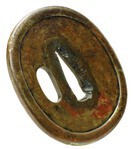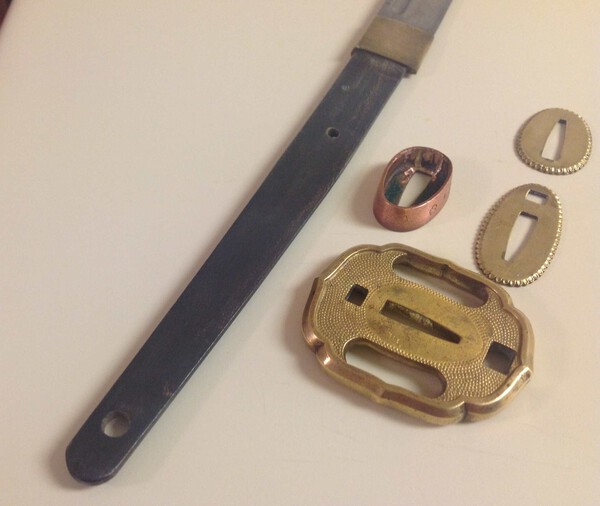-
Posts
2,452 -
Joined
-
Last visited
-
Days Won
21
Content Type
Profiles
Forums
Events
Store
Downloads
Gallery
Everything posted by Toryu2020
-
great stuff Gentlemen- This is one of those friend of a friend items. i have yet to see it in hand but once i do will post some more photos for the final verdict... thanks, -t
-
I want to ask, is this not a gendai work? Are we maybe looking in the wrong place for this smith? The depth of the ha-machi especially makes me wonder. 龍虎 BTW is the theme of the tsuba - dragon on one side and tiger on the other... -t
-
Henk - You may have read my use of the word harass too literally. There is a style of instruction where you take the student by the hand and lead him through all he needs to know. Then there is the class that challenges the student from the beginning to read his surroundings and copy the actions of others or suffer for his inattention. The student is forced to dissect the techniques himself and all his realizations are earned by him rather than given. As a "westerner" I am criticized by my teacher when I try to explain things to the students; "talking to them makes them stupid!" is something I often hear. As for "ranking" folks, it is important to know who is a teacher or senior student and to address them properly. I think in any large gathering we unconsciously do this. It is not to be critical or to point out others and certainly not something verbalized. We might push people hard but we are always polite :D
-
Folks - Would you all say this is a Chinese fake pretending to be something she is not or a late-War something or other that someone has gussied up by polishing all the parts and painting the same black? No where near Slough at the moment so will appreciate any input. -t
-
My little handbook of Japanese mon lists no less than 96 families that used this mon in the Edo period, the Takenaka being the most famous, it notes that more than 200 families (they mean families that count) used variations of the take mon during the more two hundred years of Tokugawa rule. If you have an object with more than one mon on it, it may be possible to connect it to a particular generation of a particular family as the main house, the mothers house and the particular generation could be represented by mon. For this you need a copy of the Taisei Bukan which is a who's who of Edo-jidai Japan... -t
-
Very nice Franco - keep those pictures coming! -t
-
Ok so no real sources to cite here but I offer the following; It is said that Takeda Shingen developed the mukade tsuba for his Mukade-tai, his elite guard and messenger corps, marking them as members and important individuals among his troops. Just as the shu-saya or ichiban yari marked someone of exceptional bravery or as a member of the vanguard. There was a tale related years ago in the JSSUS about a samurai that discovered a famous tsuba while on a mission for his lord in the provinces, upon returning home he realized he could not wear it publicly and would never have come across it without the patronage of his lord, he therefore made a gift of it to his daimyo, for which he was rewarded. He was then faced with the question whether or not to compensate the seller as the tsuba had now become much more valuable than even he had thought when he purchased it. A tale certainly, but one told to teach the us the values of the time; don't wear tsuba/koshirae above your station, don't take advantage of the ignorant, don't covet valuable swords and tsuba! Yagyu tsuba are said carry the message of individual teachings from the famous school of swordsmanship but may also have marked the wearer as a member of the ryu, as a school supported by the Tokugawa this may have meant you were someone of some importance and not just a "fan." Culturally it makes perfect sense, in todays' Kendo dojo if you were to show up in super high class bogu on your first day you would be subjected to constant harassment until either your skills matched your equipment or you quit! This is not a new attitude. In Iaido we eschew flashy dress and koshirae for shinsa and embu most especially for beginners. There is a great deal of examination of the kit and comportment of new faces, if someones rank is known you know how to behave, but if new you check them out and "rank" them based on appearance and performance, including what equipment they employ. How many cheap poorly made koshirae have you seen with an exceptional top class tsuba attached? How many well made koshirae have you seen where the tsuba has been removed or swapped out with something that clearly does not fit? An untouched specimen of a period koshirae is a thing of beauty no matter the quality but the qualities are clear and all the parts seem to fit the "rank" do they not? My own teacher says that the choice of tsuba was more important than the choice of sword for it tells the world what kind of man you are, and once the sword is drawn "the tsuba is just a hand-stop and the blade simply a weapon." In short I agree with the idea, while "sources" and clear evidence may require some work on our part I feel confident that the idea is a correct one. -t
-

Koshirae Book available now in English
Toryu2020 replied to Markus's topic in General Nihonto Related Discussion
i have both the paperback and the eBook. terrific stuff here. the only regret is the the paper has no color images and the electronic images are not a higher resolution. love all that I have read so far. -t -
I would have to disagree with John - The Samurai Sword is where you need to start. It is a very good introduction and indeed has excellent references for variations in written kanji as seen in signatures. The connoisseurs book is a fantastic overview of the whole study focused on the practice of kantei. I feel you need to master the terminology and history and maybe get to know some of the more famous names before tackling this book. I recommend you start with Yumoto Sensei's book and then read The Japanese Sword by Sato Kanzan which also introduces the subject of fittings and koshirae and has some great illustrations. If you totally devour these two books and can't wait for more move on to the more advanced books - keeping in mind unless you are seeing real swords in hand, the connoisseurs book is just a lot of names, dates and jargon. mho -t PS Nakahara Sensei has a unique few on several subjects that I think are best appreciated after the "established" view is understood.
-
I'm Guessing Unryu-shi Minamoto Michikuni saku 雲龍子源道国作
-
And so it is! And now I see what Ron was talking about. Looking at the article and some other references I did not find this variation used, although there was some in the tsuki hen which is what I thought we were after. -t
-
Ron - your paper says "Tsuba" Jiro Taro Naokatsu and they use the same form of katsu... -t
-
So Ron or Paul, Where or when was the article translated? Anyone willing to share? -t
-
I'm gonna guess Sadatsugu kitau kore 貞俊鍛之 For the Showa-to Tojiro saku 藤次郎作 For the knife Eishin with kao 影進 kao For the bow -t
-
"But what of Sakura-han? Sakura castle built by Chiba Suketane, was the base for the Kunô and Matsudaira families before being rebuilt by the Doi Family in 1610, when it was enlarged and improved upon. Not long after it changed hands again passing to several families until it was given in fief to the Hotta family in 1745. Not far from Sakura castle, there was a large smithy, Kajisaku, established by the Han early in the Edo period. The Kunitomo gunsmiths worked here as well as Fujieda Haruhiro among others. It seems that some Edo smiths may have traveled out here to work in what was a kind of forge for hire. Students of Masahide, like Masayoshi and Tadayoshi may also have rented workspace here and this may be the true origin of Tadayoshis’ Sakura connexion, though there are other theories." Excerpted from the article on Hosokawa Tadayoshi orignially published in Tô-Ron, now on my website...
-
You might look up info on the Tenshozan smiths, I believe he may have been one of these... -t
-
My guess would be 関善定尾吉時作 Seki Zenjo O Yoshitoki saku - Second generation... -t
-

visit to Pierre Nadeau's forge
Toryu2020 replied to b.hennick's topic in General Nihonto Related Discussion
http://www.soulsmithing.com/Blog/ A man with a heart of gold and a soul of steel! Personally can't wait to see what wonderful things come out of his efforts. Have always enjoyed his blog and wish him great success in hi enterprise. Thanks Barry for sharing very jealous that I myself have not been able to visit... -t -
Curtis - Remember this is a name and not a poem or a sentence. Look at other signatures of 8 or more characters and look for the kind of info contained therein. Most entry level books on swords will have examples, The Samurai Sword by Yumoto is a good start. You should not have to look at the spoilers and don't feel pressed for time, take your time and learn from the experience. I envy the position you are in. -t
-
Doesn't have to be time consuming - Start a new thread, call it "By Comparison" - post Jean's Yasumitsu and the eBay pretender. Let folks draw their own conclusions, add new photos as they come up. I think we had a good example of a dubious Naotane not too long ago. Might not be too hard to find those photos for comparison... -t
-
You know if I saw pictures of Jean's sword before looking at swords on eBay I would likely never buy anything for sale there. Brian - are you listening? Wouldn't it be nice to collect somewhere here comparison photos say of gimei/shoshin and papered examples like this next to dubious examples like the one from the listing/link? Right now if I want to see and compare examples I have to troll by smiths name - I think only a few examples would be needed and it could be titled "Look here before you eBay Baybay!" or something to that effect... -t
-
雷除 日出山但馬守藤原朝亞入道 Suspect this is a , should be able to figure it out with the detailed info he has given us... -t
-
Great Fun!
-
Ron - Your question brings up a question asked at a recent meeting of the NCJSC: it seems a number of these pieces were produced by the Jingo artists. Some fresh and untouched, others obviously distressed and obviously artificially aged. These may be seen even in the fine volumes by Ito, but I do not believe they are fully explained. Does anyone know why this theme was seemingly so popular and why the Jingo artists would heave done different versions? any help appreciated, -t





